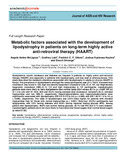Metabolic factors associated with the development of lipodystrophy in patients on long-term highly active anti-retroviral therapy (HAART

View/
Date
2013-05Author
Omonge, Enoch
Kayima, Joshua Kyateesa
Otieno, Fredrick C F
Lule, Godfrey
McLigeyo, Angela Awino
Type
ArticleLanguage
enMetadata
Show full item recordAbstract
Dyslipidemia, insulin resistance and diabetes are frequent in patients on highly active anti-retroviral
therapy (HAART) and especially in patients with lipodystrophy, and may lead to atherosclerosis. This
study described the metabolic alterations associated with lipodystrophy in adults on chronic HAART in
Kenya. The prevalence of dyslipidaemia amongst the study participants was (211) 79.6%. Elevated total
cholesterol was found in 129, high low-density-lipoprotein cholesterol (LDL-C) in 107, low High-density
lipoprotein cholesterol (HDL-C) in 110 and high triglycerides in 131 participants. Lipodystrophic
patients were more likely to have dyslipidemia than normal lipids (55.4 versus 35.1%, p = 0.007 OR 2.2
CI 1.3 to 4.6) with 57, 45.9, 65.9 and 45.2% having elevated total cholesterol, elevated LDL-C, elevated
triglycerides and low HDL-C, respectively. Hypertriglyceridemia and hypercholesterolemia were
significantly associated with lipodystrophy (OR 3.8 CI 2.3 to 6.4; p = 0.000) and (OR 1.94 CI 1.2 to 3.2; p
= 0.008), respectively. The odds of lipodystrophy was 2.913 times higher for patients with elevated
triglycerides than for those with normal triglycerides (p < 0.001). Sixty-four (24.3%) participants had
dysglycemia, with 3.5% having diabetes and 20.8% having impaired fasting glucose (IFG). Among
patient with lipodystrophy, 69.8% had normal fasting glucose, 25.1% had IFG and 5.1% were diabetic.
Lipodystrophic patients were not more likely to have abnormal blood sugars than normal blood sugars
(p value 0.125).
Citation
Journal of AIDS and HIV Research Vol. 5(5), pp. 142-148, May, 2013Publisher
School of Medicine
Subject
metabolic alterationschronic highly active anti-retroviral therapy (HAART)
lipodystrophy
dysglycemia
fasting glucose
atherosclerosis
Dyslipidemia
Collections
- School of Medicine [15]
